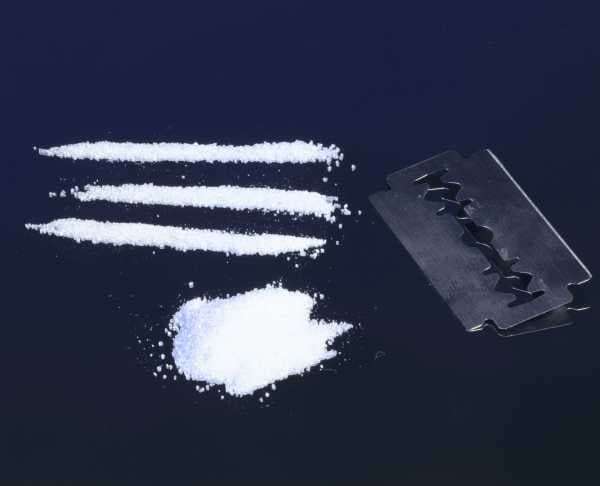
America’s opioid epidemic is affecting overdoses involving a wholly different class of drugs: cocaine.
Over the past few years, illicit fentanyl and related synthetic opioids have become the dominant cause of overdose deaths in the opioid crisis. But federal data shows that fentanyl and its analogs have also increasingly appeared in cocaine overdose deaths.
In 2012, there were a little more than 4,400 overdose deaths involving cocaine. About 180 of those deaths involved fentanyl or other synthetic opioids (excluding methadone) too. Since then, the number of cocaine overdose deaths has more than doubled — to nearly 10,400 in 2016, the latest year of full federal data. At the same time, the number of overdose deaths involving cocaine and synthetic opioids rose even more sharply, rising to nearly 4,200 in 2016. Overdose deaths involving both cocaine and heroin also increased, but not as quickly.
The rise in deaths involving both cocaine and fentanyl is startling to experts, with big implications for America’s ongoing drug overdose crisis.
Cocaine overdose deaths are disproportionately more common among black people — a group that has, to this point, not been hit as hard as white people by the opioid crisis. The growing link between cocaine and fentanyl could indicate that America’s opioid epidemic is increasingly reaching a new class of drug users.
But why are these overdose deaths involving cocaine and fentanyl spiking?
“None of us really knows what’s going on,” Keith Humphreys, a drug policy expert at Stanford University, told me, referencing his conversations with other experts. “I can tell you my guesses, but I’m pretty sure no one really, honestly knows what’s going on.”
Are drug users mixing cocaine with fentanyl (or vice versa)? Are drug dealers doing it — on accident or on purpose? Does better detection of these kinds of overdoses explain at least some of the deaths? The experts I spoke with said that it’s likely a mix of all the above, but all of these explanations are speculative.
The implication, though, is that America really needs to take a comprehensive look at how it responds to drug misuse and addiction. While the opioid crisis has rightly invigorated more attention and investment toward opioid addiction treatment, preparing for the next drug crisis — and responding to the current one, as overdose deaths involving non-opioids rise — will require a broader approach.
But to start, let’s look at why cocaine-fentanyl overdose deaths are rising in the first place.
Explanation 1: users are purposely mixing cocaine with fentanyl
First of all, the presence of cocaine and fentanyl in a toxicology report for an overdose death does not necessarily mean that the drugs were used at the same time. They could have been used at separate periods and remained in the victim’s system. As Humphreys noted, it’s common for people who use drugs to use multiple substances, from marijuana to alcohol to cocaine to fentanyl.
Still, mixing the drugs and using them together is certainly possible. The mix of cocaine and heroin, known as a “speedball,” has long been popular among people who use drugs. And as the heroin in the illicit drug market is increasingly replaced by fentanyl, the heroin in the popular mix is also being replaced by fentanyl and its analogs.
“Speedball’s a classic,” Daniel Ciccarone, an epidemiologist at the University of California San Francisco, told me. “It’s not going away.”
This is the simplest — and, experts told me, most plausible — explanation for why drug overdose deaths involving both cocaine and synthetic opioids have gone up: As more people use illicit opioids, a certain segment of this growing population is going to add cocaine to the mix for a bigger kick or use cocaine on the side, and that will lead to more overdose deaths in which both drugs are detected in toxicology reports.
A complicating factor is that people often don’t know they’re using fentanyl instead of heroin.
Over the past few years, drug dealers have increasingly sold fentanyl under the guise of heroin. They have a profit motive to do that: Fentanyl is generally cheaper and it’s far more potent, so a seller can make more money for lower amounts of the drug. Because it’s an opioid, there’s a chance the buyer won’t notice it’s not actually heroin — they may think it’s just an extra-potent version of the drug.
But fentanyl — and particularly its analogs, such as carfentanil — is much more potent than heroin, so it also carries a higher overdose risk. This risk is even higher if a user doesn’t know that the “heroin” is actually fentanyl; if someone tries to use the same amount of powder they would use if it were heroin, for example, that might end up being a much, much stronger dose of fentanyl or one of its analogs.
Cocaine and heroin already escalate each other’s overdose risk. If that heroin is actually fentanyl instead, or at least laced with fentanyl, the risk is even higher — and helps explain at least some of the rise in overdose deaths.
Explanation 2: dealers are purposely mixing cocaine with fentanyl
Another possible explanation is that the mixing is happening not at the user level but at the dealer or trafficker level. With or without the buyer’s knowledge, drug sellers or someone up the chain may be mixing cocaine and fentanyl before the product hits the street.
There is some data to support this. New York City Police Department laboratory testing, for one, found that about 1 percent of cocaine that it analyzed tested positive for fentanyl from January to March 2017. Christopher Moraff, a freelance journalist and co-host of the soon-to be-released podcast Narcotica, has found in his own testing of street drugs a few samples of cocaine that were contaminated with fentanyl, but he noted that this is still rare. And Julia Lurie at Mother Jones and Scott Pham and Dan Vergano at BuzzFeed reported stories of some people who meant to use cocaine and ended up inadvertently ingesting fentanyl too, causing an overdose.
Sarah Wakeman, the medical director at the Massachusetts General Hospital Substance Use Disorder Initiative, told me this is something she’s witnessed in her own practice: “I have seen patients who use cocaine who have had positive fentanyl toxicology, and I have also seen people who thought they were using heroin/fentanyl who tested positive for cocaine.”
There are two reasons typically given for why drug dealers would do this: One, it’s a relatively cheap way to give a product a bit more kick. Two, it could be an attempt to get cocaine buyers hooked on opioids.
Experts, however, are very skeptical that deliberate mixing is widespread.
For one, people who are buying cocaine want cocaine, and they’re going to be unhappy if a totally different drug ends up in what they buy. Cocaine is an upper, and fentanyl, like other opioids, is a downer — so cocaine and fentanyl have generally opposite effects, which can be unpleasant to someone who wants a pure upper or downer experience.
“When you go into a Starbucks, you expect a certain quality of coffee. And if it comes out different that day, you’re like, ‘WTF?’” Ciccarone said. People who use drugs, he added, have similar expectations.
Besides, at this point, drug dealers have to be aware of the deadliness of fentanyl — given that it’s been all over the news for years. In that light, they would have to know that adding fentanyl to their cocaine could seriously risk killing their customers — an outcome that’s, if nothing else, bad for business.
And, experts noted, why would a seller who already has a customer buying cocaine feel the need to additionally get that customer addicted to and using fentanyl?
“You’re already making money off this person,” Humphreys said. “Why would you want to kill them or piss them off?”
Still, it’s not completely unprecedented for this kind of thing to happen. Kathleen Frydl, a historian and author of The Drug Wars in America, 1940-1973, told me this is something that happened during the Vietnam War: US military soldiers in South Vietnam were tricked into trying heroin with the claim that it was cocaine, and that led some of them to a heroin addiction. Maybe something similar is going on here.
But so far, the evidence suggests that this is very rare — given that cocaine samples are still, based on NYPD data and Moraff’s reports, by and large coming back negative for fentanyl. So, as Ciccarone told me, this explanation is still “highly speculative.”
Explanation 3: dealers are accidentally mixing cocaine with fentanyl
Another possibility is that drug dealers and traffickers are accidentally mixing cocaine and fentanyl. For example, they might be using the same table or sink to cut different batches of cocaine and fentanyl without cleaning the space beforehand. That could lead to accidental cross-contamination.
This avoids the big criticism of the deliberate mixing explanation: It’s not that these sellers are taking the risk of pissing off or even killing their customers for some nefarious scheme to give their product more kick or get buyers addicted to other drugs; they just don’t know what they’re doing.
Which explanation is more likely: deliberate or accidental mixing? Experts aren’t sure.
“I still think those are the minority of cases,” Ciccarone said, referring to cases in which a seller mixed cocaine and fentanyl, whether deliberately or accidentally. “And those I can’t explain.”
Explanation 4: better data collection
One wonky explanation is that maybe this is an artifact of better data collection.
As the opioid epidemic has continued and as fentanyl has crept into the black market for drugs over the past few years, coroners and medical examiners have stepped up their toxicology reports to better account for opioids and drug overdoses in general. It’s possible that some of the uptick in cocaine-fentanyl overdose deaths is a result of better tracking — so it’s not that there’s an increase in deaths related to both these drugs, but that the causes of the deaths are better detected and reported.
This almost certainly does not explain the entire or even most of the rise in cocaine–synthetic opioid deaths, given how large the increase is and the evidence of a rise in fentanyl deaths elsewhere. But it’s at least a partial explanation.
“It doesn’t mean it’s not real,” Humphreys said. “But it could be that this has been going on for longer than we realize, and it’s now being covered as this shocking new thing.”
On the other hand, experts said that the fact we don’t know for sure why cocaine-fentanyl overdose deaths are rising is evidence that our surveillance systems could stand to improve further. With better data, we would have better answers.
Policies need to tackle all drug addiction, not just opioid addiction
Whatever the cause of the rise in these overdose deaths, experts were consistent in one message: It’s more evidence that we need to think of drug addiction treatment in a more comprehensive way.
In response to the opioid crisis over the past few years, there’s been a lot of talk of expanding addiction treatment for opioids. That’s mainly involved pushing for anti-addiction medications like methadone, buprenorphine, and naltrexone. These are the gold standard for opioid addiction treatment, with studies finding that they reduce the mortality rate among opioid addiction patients by half or more and do a far better job keeping people in treatment than nonmedication approaches.
When it comes to cocaine, though, there is no equivalent medication. Treating cocaine addiction, instead, typically involves other methods: cognitive behavioral therapy, group therapy, motivational interviewing, mutual support groups, contingency management, and other psychological and social interventions. These are the kinds of approaces that will be needed to stop the rise in cocaine overdose deaths, regardless of whether they involve fentanyl.
Experts are happy to see all the talk about expanding addiction treatment for opioids. But they’re worried that infrastructure won’t additionally be built up to deal with other kinds of addiction, from alcohol to cocaine to meth.
After all, many people who use drugs use multiple drugs, so treating just their heroin or fentanyl addiction won’t address the full scope of their problems. A broader approach is also a chance to respond to the current rise in overdose deaths, and to build the systems that could shield us from the next drug overdose crisis — one that may not involve opioids at all.
Consider: The 2016 surgeon general report on addiction found that only 10 percent of people with any substance use disorder get specialty treatment, largely because access to all kinds of care in this area is poor. That suggests a problem not just for people with opioid use disorders, but for people with substance use disorders involving alcohol, cocaine, meth, and other drugs as well.
“Until we truly embrace this as a medical issue and embed treatment into our health care and public health systems, we will never be able to effectively meet the tremendous need of all those affected by addiction,” Wakeman said.
It goes beyond treatment too. Ciccarone argued that America needs to do more to address the “root causes” of drug addiction. He pointed to the rise in overdose deaths as well as alcohol-related deaths and suicides as proof “that there’s this social malaise out there.” Addressing the deeper problems, he said, will require broader social and economic reforms than have been discussed so far.
Experts acknowledge that tackling all of this — from more comprehensive treatment to the root causes of addiction — will require far more, in terms of political will and money, than just scaling up opioid addiction treatment. But if America really wants to come to grips with its addiction problem, the increase in cocaine overdose deaths shows that it may be necessary.
Sourse: vox.com






